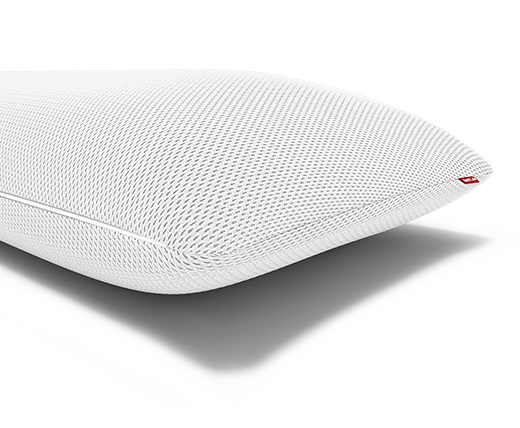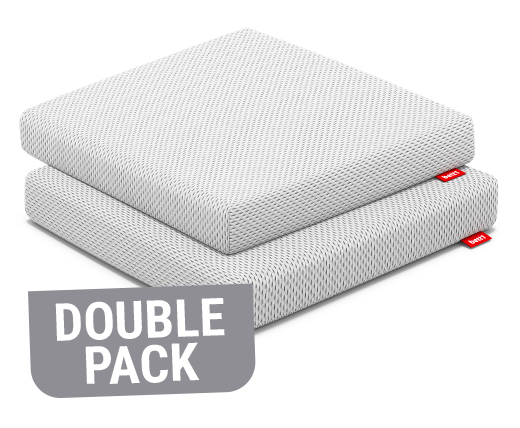
Pillows and Cushions
A mattress and slatted frame alone do not make a bed. In most cultures, the pillow is an indispensable part of the bed. The choice of pillows is huge. The search for the right pillow is like a pillow fight. First and foremost, a pillow should be comfortable, but is that enough as a selection criterion? As a headrest, the pillow has an important supporting function. The right pillow can not only prevent tension, it can even reduce snoring under certain circumstances.
Adjusting the Pillow for the Lateral Position
The height of the pillow should be based on your shoulder width. You can easily determine the pillow height at home: Stand loosely with your shoulder against a wall and measure the distance between your head and the wall. From the measured value, roughly subtract the centimetres that your shoulder sinks into the mattress.
Adjusting the Pillow for the Supine Position
To determine the correct height, stand with your back relaxed against a wall and look straight ahead. The measured distance between the wall and the back of your head is the optimum pillow height. When choosing the size of the pillow, you should make sure that you only lie with your head and neck on the pillow, but not with your shoulders.
The Right Pillow for Every Situation
The pillow is not just a simple headrest: it should provide sufficient support for the head and neck to relieve pressure on the vertebrae and muscles. The pillow therefore makes a significant contribution to restful sleep. This is achieved by the pillow filling the gap between the head and mattress, which varies depending on the sleeping position and from person to person. Whether you sleep on your back, stomach or side, different pillows are advertised for each sleep type. Most pillows are only suitable for this one sleeping position. However, the sleeping position usually only determines how we fall asleep. We turn from our back to our side and back again numerous times during the night. Pillows that support different sleeping positions are therefore advantageous.
Pillow for Sleeping on Your Side
More than half of all people prefer to sleep on their side. This is why there is a particularly wide range of pillows for side sleepers. In the lateral position, it is crucial for relaxed sleep that the spine forms a continuous, straight line. To ensure this, a pillow that supports the head well is required in addition to an ergonomically good mattress. The shoulder must not rest on the pillow and thus be prevented from sinking into the mattress. The narrower comfort pillow is more suitable for side sleepers than the large standard pillow. The shoulder sinks deeper into a soft mattress than into a firm one, so the pillow should be somewhat flatter when using a soft mattress.

The term side sleeper pillow also includes pillows in special sizes and shapes. In addition to supporting the head and neck, they also serve other areas that are stressed when lying on your side: the hip and knee area. The knee pillow, for example, is used when lying on your side to relieve pressure on the hips and relax the knees and thighs. Long, narrow side sleeper pillows in a 7-, U- or C-shape fulfil this support function for the whole body. The sleeping person hugs these pillows and places them between their legs. The posture of the spine is supported and the sleeping position is prevented from slipping towards the stomach.
Pillows for sleeping on your back
One in five people prefer to sleep on their back. The advantages of lying on your back are that the muscles, ligaments and fasciae are stretched in a relaxed manner. Choosing a pillow for this sleeping position is relatively simple. In most cases, a flat pillow is sufficient to support the natural S-shape of the spine.
Pillow for Sleeping in the Prone Position
Few people sleep in the prone position. Sleeping on your stomach is often not recommended, as the neck vertebrae are in a very twisted position. The prone position can also restrict breathing. If the pillow is too high, the cervical vertebrae are overstretched and there is a risk of tension in the neck and shoulder area. Experts question the benefits of special pillows for stomach sleepers on the market. It is helpful to use a flat and soft surface when lying on your stomach or to do without a pillow altogether.
The right filling for every head
Filling materials for pillows mainly have an influence on the feeling of lying down. Most synthetic and natural pillow fillings fulfil basic requirements for sleeping pillows such as breathability and support in equal measure. Visco foam and foam pillows offer advantages in terms of durability, adaptability and hygiene. The latter is particularly important for people with allergies. The option of changing the height of the pillow by removing or adding filling material helps to correctly adjust the level of support required. It does not matter whether the pillow contains visco foam, latex or synthetic fibres.

Pillow care
Fluffing the pillows in the morning and washing the pillowcases regularly ensure a clean and comfortable sleeping environment - that's all you usually need. The filling of most pillows cannot usually be washed. Pillows that are suitable for cleaning in the washing machine often lose support during washing and spinning or dry slowly, which in the worst case can lead to mould.
Expect to pay around €45 to €90. First, consider your sleeping needs: do you have broad or narrow shoulders? Do you need special support? What pillow height suits you? Choose the right model for your needs.
You should replace your pillow if you are no longer sleeping well on it. At the latest, however, when it is worn out or clumped together. Even if it starts to smell unpleasant, it is high time for a new one. Some models, such as the BODYGUARD® Memory Foam Pillow, have a cover that is washable at 60 °C and removable foam flakes to adjust the height.
Pillows from bett1.de are covered with a removable HyBreeze® Cover that can be machine washed at 60°C. The foam core and foam flakes should not be washed.
Most people sleep comfortably on pillows that are 13–15 cm high. The ideal height of a pillow depends on your physique. If you have broad shoulders, choose a higher pillow – if you have narrow shoulders, choose a flatter one. Models such as the BODYGUARD® Memory Foam Pillow can be adjusted in height, while the BODYGUARD® Ergonomic Pillow offers you a choice of two different heights.
Whether you sleep on your back or side, a pillow should support the natural curve of your spine in the neck area. The BODYGUARD® Memory Foam Pillow relieves pressure on your neck and shoulders and can be adjusted to suit your needs.
















